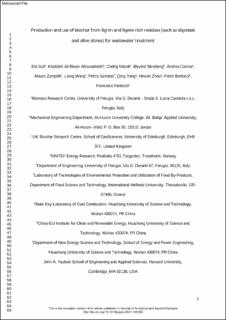| dc.contributor.author | Gul, Eid | |
| dc.contributor.author | Alrawashdeh, Khalideh Al Bkoor | |
| dc.contributor.author | Masek, Ondrej | |
| dc.contributor.author | Skreiberg, Øyvind | |
| dc.contributor.author | Corona, Andrea | |
| dc.contributor.author | Zampilli, Mauro | |
| dc.contributor.author | Wang, Liang | |
| dc.contributor.author | Samaras, Petros | |
| dc.contributor.author | Yang, Qing | |
| dc.contributor.author | Zhou, Hewen | |
| dc.contributor.author | Bartocci, Pietro | |
| dc.contributor.author | Fantozzi, Francesco | |
| dc.date.accessioned | 2022-07-29T07:36:55Z | |
| dc.date.available | 2022-07-29T07:36:55Z | |
| dc.date.created | 2021-07-10T21:33:19Z | |
| dc.date.issued | 2021 | |
| dc.identifier.issn | 0165-2370 | |
| dc.identifier.uri | https://hdl.handle.net/11250/3009112 | |
| dc.description.abstract | Clean water is an essential resource for life, and its demand is continuously increasing with the rapid growth in population, while the freshwater reserves are also depleting. A large amount of wastewater is released by different industries, which is affecting the environment as well as polluting the freshwater reserves. Recycling and treatment of wastewater are highly essential to meet the demand for clean water and to protect the environment. Activated carbon can be used in primary, secondary and tertiary wastewater treatment steps. It can be used to capture pollutants which stop microbial activity or to produce clean water with high purity. About 3 million tons of activated carbon are produced per year and it is mainly used for fluid purification. The objective of this review is to investigate the preparation and production of biochar from lignin which is an important resource available in great quantities (about 100 Million tons per year) and the practical application of it for wastewater treatment. Biochar can be produced through pyrolysis (at temperatures of 600-700 °C) and hydrothermal carbonization (at temperature between 180-300 °C). Subsequent activation can be performed in two ways (physical and chemical), usually at temperatures between 600-800 °C. The quality of biochar and activated carbon produced from lignin-rich residue can be very high, even though the costs also are higher respect to other fossil derived materials (carbon black, lignite and pet coke). | en_US |
| dc.description.abstract | Production and use of biochar from lignin and lignin-rich residues (such as digestate and olive stones) for wastewater treatment | en_US |
| dc.language.iso | eng | en_US |
| dc.publisher | Elsevier | en_US |
| dc.rights | Attribution-NonCommercial-NoDerivatives 4.0 Internasjonal | * |
| dc.rights.uri | http://creativecommons.org/licenses/by-nc-nd/4.0/deed.no | * |
| dc.title | Production and use of biochar from lignin and lignin-rich residues (such as digestate and olive stones) for wastewater treatment | en_US |
| dc.title.alternative | Production and use of biochar from lignin and lignin-rich residues (such as digestate and olive stones) for wastewater treatment | en_US |
| dc.type | Peer reviewed | en_US |
| dc.type | Journal article | en_US |
| dc.description.version | acceptedVersion | en_US |
| dc.source.volume | 158 | en_US |
| dc.source.journal | Journal of Analytical and Applied Pyrolysis | en_US |
| dc.identifier.doi | 10.1016/j.jaap.2021.105263 | |
| dc.identifier.cristin | 1921334 | |
| dc.relation.project | Norges forskningsråd: 294679 | en_US |
| dc.relation.project | EC/H2020/101018756 | en_US |
| dc.source.articlenumber | 105263 | en_US |
| cristin.ispublished | true | |
| cristin.fulltext | postprint | |
| cristin.qualitycode | 1 | |

